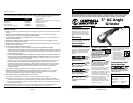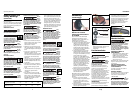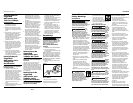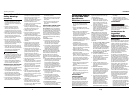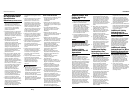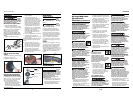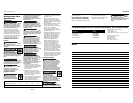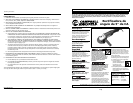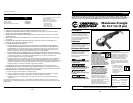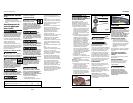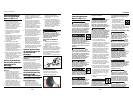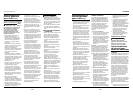
Manual de Instrucciones
22 Sp
fuerzas de reacción a la torsión o
contragolpe si toma las
precauciones necesarias.
2. Nunca ponga las manos cerca del
accesorio en rotación. El accesorio
puede dar un contragolpe contra su
mano.
3. No posicione su cuerpo en el área
donde la herramienta eléctrica
podría desplazarse si se produjera
un contragolpe. El contragolpe
desplaza la herramienta en
dirección opuesta al movimiento de
la rueda en el punto donde ha
quedado atascada.
4. Ponga especial atención cuando
trabaja con ángulos, bordes filosos,
etc. Evite que el accesorio rebote o
quede apretado. Los ángulos, los
bordes filosos y los rebotes tienden
a apretar el accesorio en rotación y
causan pérdida de control o el
contragolpe.
5. No monte una hoja de esculpir
madera de una sierra de cadena o
una hoja de sierra dentada. Esas
hojas causan frecuentes
contragolpes y pérdidas de control.
Instrucciones de
Seguridad
Adicionales para
Trabajos de
Rectificación
ADVERTENCIAS DE SEGURIDAD
ESPECÍFICAS PARA LOS TRABAJOS
DE RECTIFICACIÓN:
1. Use siempre los protectores
diseñados para el tipo de rueda que
está empleando. El protector debe
estar firmemente sujetado a la
herramienta eléctrica y en la
posición de máxima seguridad, de
tal manera que la menor parte
posible de la rueda quede expuesta
hacia el operador. El protector
ayuda a proteger el operador de
fragmentos de una rueda dañada y
del contacto accidental con la
rueda.
2. Use sólo los tipos de rueda
recomendados para su herramienta
eléctrica y el protector
especialmente diseñado para la
rueda seleccionada. Las ruedas
diseñadas para una herramienta
eléctrica diferente no permiten el
uso adecuado del protector y son
peligrosas.
3. Las ruedas deben usarse sólo para
las aplicaciones recomendadas. Por
ejemplo: no haga trabajos de
rectificación usando la cara de una
hoja de corte. Las hojas de corte
abrasivas están diseñadas para
rectificación periférica: el aplicar
fuerzas laterales a estas ruedas
puede causar que se quiebren.
4. Use siempre bridas sin daños y del
tamaño y forma correctos para la
rueda seleccionada. Las bridas
apropiadas proporcionan buen
soporte limitando así la posibilidad
de que la rueda de quiebre. Las
bridas para las ruedas de corte
pueden ser diferentes de las bridas
para las ruedas rectificadoras.
5. No use ruedas desgastadas aptas
para herramientas eléctricas de
tamaño más grande. Las ruedas
diseñadas para herramientas
eléctricas más grandes no son aptas
para la velocidad más elevada de
una herramienta más pequeña y
pueden estallar.
Instrucciones de
Seguridad
Adicionales para
Trabajos de Lijado
ADVERTENCIAS DE SEGURIDAD
ESPECÍFICAS PARA LOS TRABAJOS
DE LIJADO:
Para lijar, evite el uso de discos de
papel de lija de tamaño excesivo.
Cuando selecciona el papel de lija, siga
las recomendaciones del fabricante. El
papel de lija demasiado grande que se
extiende por fuera de la almohadilla de
soporte presenta el riesgo de romperse
y puede causar atascos, rotura del disco
o contragolpes.
Instrucciones de
Seguridad
Adicionales para
Trabajos con el
Cepillo de Alambre
ADVERTENCIAS DE SEGURIDAD
ESPECÍFICAS PARA LOS TRABAJOS
CON CEPILLO DE ALAMBRE:
1. Tenga en cuenta que unas cerdas
de alambre pueden desprenderse
del cepillo durante el
funcionamiento normal. No fuerce
los alambres excesivamente
aplicando demasiada presión sobre
el cepillo. Las cerdas de alambre
pueden penetrar fácilmente ropa
liviana y/o la piel.
2. Si se recomienda el uso de un
protector para los trabajos con el
cepillo de alambre, no permita
ningún contacto entre la rueda de
alambre o el cepillo y el protector.
La rueda de alambre o el cepillo
pueden aumentar el diámetro
debido a la presión aplicada y las
fuerzas centrífugas.
Ensamblaje
Siempre
retire el
cable de electricidad de la fuente de
electricidad antes de cambiar la rueda
abrasiva, los cepillos, de lubricar o al
trabajar en la unidad, para evitar
posibles lesiones graves.
INSTALACIÓN DEL MANGO
LATERAL
1. DESENCHUFE LA RECTIFICADORA.
2. Instale el mango lateral
atornillándolo al costado de la caja
de engranajes.
Nota: el mango se puede instalar del
lado izquierdo, derecho o superior de
la rectificadora, según la preferencia
del operador. EL MANGO LATERAL
DEBE USARSE SIEMPRE PARA EVITAR
LA PÉRDIDA DE CONTROL Y POSIBLES
LESIONES GRAVES.
3. Ajuste el mango lateral de modo
seguro.
CÓMO AJUSTAR LA PROTECCIÓN
DE LA RUEDA
1.Afloje el tornillo hexagonal.
2.Ajuste la cubierta de la rueda.
3.Ajuste el tornillo hexagonal.
Instrucciones de
Seguridad
Adicionales para
Todos los Trabajos
(Continuacion)
3
DG470800CK
www.chpower.com
If devices
are pro-
vided for the connection of dust
extraction and collection facilities,
ensure these are connected and proper-
ly used. Use of dust collection can
reduce dust-related hazards.
Do
not
misuse this product. Excessive
exposure to vibration, work in
awkward positions, and repetitive
work motions can cause injury to
hands and arms. Stop using any tool if
discomfort, numbness, tingling, or pain
occur, and consult a physician.
• Wear personal protective equipment.
Depending on application, use face
shield, safety goggles or safety
glasses. As appropriate, wear dust
mask, hearing protectors, gloves and
shop apron capable of stopping small
abrasive or workpiece fragments.
The eye protection must be capable
of stopping flying debris generated
by various operations. The dust mask
or respirator must be capable of
filtrating particles generated by your
operation. Prolonged exposure to
high intensity noise may cause
hearing loss.
• Always work in a well-ventilated
area. Wear an OSHA-approved dust
mask.
• Hold tool by insulated gripping
surface when performing an
operation where the tool may
contact hidden wiring. Contacting a
“live” wire will make exposed metal
parts of the tool “live” and shock the
operator.
• Keep hands away from rotating parts.
When servicing tools, use
only identical replacement
parts. Follow instructions in
the Maintenance section of this
manual. Use of unauthorized parts or
failure to follow maintenance
instructions may create a risk of
electric shock or injury.
• Some woods contain
preservatives which can be
toxic. Take extra care to
prevent inhalation and
skin contact when working with
these materials. Request and follow
all safety information available from
your material supplier.
POWER TOOL USE AND CARE
Do not
force the
power tool. Use the correct power tool
for your application. The correct power
tool will do the job better and safer at
the rate for which it was designed.
Do not
use the
power tool if the switch does not turn
it on and off. Any power tool that can-
not be controlled with the switch is
dangerous and must be repaired.
Disconnect the plug from the power
source and/or the battery pack from
the power tool before making any
adjustments, changing accessories, or
storing power tools. Such preventive
safety measures reduce the risk of
starting the power tool accidentally.
Store
idle
power tools out of the reach of chil-
dren and do not allow persons unfamil-
iar with the power tool or these
instructions to operate the power tool.
Power tools are dangerous in the
hands of untrained users.
Maintain
power
tools. Check for misalignment or bind-
ing of moving parts, breakage of parts
and any other condition that may
affect the power tool’s operation. If
damaged, have the power tool
repaired before use. Many accidents
are caused by poorly maintained power
tools.
Keep
cutting
tools sharp and clean. Properly main-
tained cutting tools with sharp cutting
edges are less likely to bind and are
easier to control.
Use the
power
tool, accessories and tool bits etc. in
accordance with these instructions,
taking into account the working condi-
tions and the work to be performed.
Use of the power tool for operations
different from those intended could
result in a hazardous situation.
• Do not use accessories which are not
specifically designed and
recommended by the tool
manufacturer. Just because the
accessory can be attached to your
power tool, it does not assure safe
operation.
• The rated speed of the accessory
must be at least equal to the
maximum speed marked on the
power tool. Accessories running
faster than their rated speed can fly
apart.
• The outside diameter and the
thickness of your accessory must be
within the capacity rating of your
power tool. Incorrectly sized
accessories cannot be adequately
guarded or controlled.
• The arbor size of wheels, flanges,
backing pads or any other accessory
must properly fit the spindle of the
power tool. Accessories with arbor
holes that do not match the
mounting hardware of the power
tool will run out of balance, vibrate
excessively and may cause loss of
control.
• Do not use a damaged accessory.
Before each use inspect the accessory
for chips and cracks, backing pad for
cracks, tear or excess wear, wire
brush for loose or cracked wires. If
power tool or accessory is dropped,
inspect for damage or install an
undamaged accessory. After
inspecting and installing an
accessory, position yourself and
bystanders away from the plane of
the rotating accessory and run the
power tool at maximum no load
speed for one minute. Damaged
accessories will normally break apart
during this test time.
• Keep bystanders a safe distance away
from work area. Anyone entering
the work area must wear personal
protective equipment. Fragments of
workpiece or of a broken accessory
may fly away and cause injury
beyond immediate area of
operation.
• Hold power tool by insulated
gripping surfaces only, when
performing an operation where the
cutting accessory may contact hidden
General Power Tool
Safety Warnings
(Continued)
Figura 1



